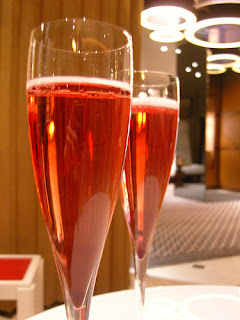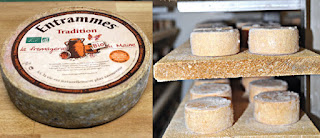from
Behind the French Menu
by
Bryan G. Newman
behindthefrenchmenu@gmail.com
Baies de Cassis or Groseilles Noirs
Blackcurrants
Photograph courtesy of Karen Jackson
https://www.flickr.com/photos/72284410@N08/9930651595/
Blackcurrants in France's history.
Blackcurrants are one of France’s favorite fruits. It is a wholly French fruit and not one of the many that arrived with those Mediterranean sea-based wholesalers the Phoenicians. The Phonecians were responsible for spreading many fruits, vegetables and herbs around the Mediterranean. The other usual suspects who brought fruits, vines and trees, including apricots and cherries, to France were the Romans and the Greeks; however, the blackcurrant was there before all of them. Blackcurrants have grown wild in France for thousands of years.
Blackcurrant Cheesecake
The blackcurrant in French cuisine today.
Blackcurrants are enmeshed in modern French cuisine. Blackcurrant may be the jam offered at breakfast, in the flavor of an hors d’oeuvre or as a sauce for an entrée, the French first course. Then blackcurrants may be the sauce for a main dish or part of a dessert or fresh blackcurrants, alone, or with chantilly cream and possibly other berries may be the dessert.
Crème de Cassis and Ratafias.
Then there are many many Frenchmen and French women, along with many visitors, who consider blackcurrants are at their best in one of France’s favorite alcoholic eau-de vie’s: Crème de Cassis. While the greater part of Creme de Cassis may be flavoring alcoholic drinks another part is the heart of flavorful blackcurrant recipes. The story of Crème de Cassis and ratafias in French cuisine may be seen further down this link.
Blackcurrants on French menus:
Baie de Cassis Frais, en Coulis - A purée of fresh blackcurrants. A fruit coulis usually includes a suitable alcoholic crème; here it will be Crème de Cassis.
Confiture de Cassis – A blackcurrant preserve or jam.
Eventail de Melon aux Baies de Cassis – Melon served in a fan or flower shape accompanied by fresh blackcurrants.
Le Sanglier Mitonné et Confit aux Baies de Cassis – A confit of wild boar slowly cooked with black currants. A confit of wild boar will have been cooked in its natural fat and stored. After one or two weeks when all the flavors have set the meat will be removed from the fat and slowly cooked again, here with blackcurrants. The wild boar in this menu listing will have been farmed. In season wild boar may be hunted, but then they would then be on the menu listing as Sanglier Sauvage.
Apple pie with blackcurrant crumble
https://www.flickr.com/photos/iaincpatterson/14973165487/
Noisette de Râble de Lièvre Sauce Poivrade aux Baies de Cassis – A small center cut from the saddle of a hare served with a Sauce Poivrade flavored with black currants. The saddle is the center of the back and the meatiest part of a rabbit or hare. The Sauce Poivrade is a red wine and meat stock based sauce often served with game; here the sauce is flavored with black currants. (Hares and rabbits are farmed in France and while they may be caught in the wild the farmed varieties are tastier and larger. Wild rabbits and hares will be stringy, though flavorful, and require marinating and a very long cooking process. Consequently, most French chefs prefer the farmed variety and If, unlikely as it may be, a wild hare was being served the menu would read lièvre sauvage ).
Magret de Canard, Sauce aux Baies de Cassis – Duck breast served with a blackcurrant sauce. Duck was and is often traditionally served with a bitter orange sauce, usually Seville oranges, but the blackcurrant has continued to gain in the popularity stakes and will be on more menus today.

Duck breast with a blackcurrant sauce,
Photograph courtesy of Ewan Munro
https://www.flickr.com/photos/55935853@N00/4286639554/sizes/l/
Mousse Citron Vert, Crémeux aux Baies de Cassis – A creamy lime mousse served with fresh black currants.
Blackcurrant, Vodka and Lemon Sorbet
https://www.flickr.com/photos/50496541@N03/5377073686/
Tournedos de Cuissot De Daguet aux Baies de Cassis Mousseline Cèleri et Rutabaga – A thick cut from the haunch of a young male deer prepared with blackcurrants and served with a mousse of celery and Swedes.
Ratafias
Ratafias were the forerunners of most alcoholic, eau-de-vies, fruit liquors including Crème de Cassis. The name ratafia comes from the Latin “rata fiat” to settle or “ratify” an agreement. Back then, as still happens today, a deal could be sealed with a drink: "let's drink on it.”
The most famous of the original ratafia style drinks available today include the Pineau de Charente from the Cognac region, which is grape juice with Cognac; Floc de Gascogne, grape juice with Armagnac; Pommeau made in Normandy with fresh apple juice and Calvados. The most famous blackcurrant ratafia is the Ratafia de Neuilly from Neuilly-sur-Seine in the department of Hauts-de-Seine which is right next to Paris. The
Ratafia de Cassis
Photograph courtesy of http://ja6.free.fr/
Ratafia and crèmes were, and are made, for the most part, by allowing different fruits to macerate, steep, in sugar and an eau-de-vie. When ready any extra alcohol required would be added and then the crème or ratafia will be bottled. Today these crèmes and ratafias are mostly part of other drinks, especially aperitifs, or in the kitchen, they will be part of a recipe that needs the creme's particular flavor. Ratafias are all slightly sweet, as they contain a significant amount of sugar, and are usually served chilled as an apéritif.
Crème de Cassis
With the popularity of the Ratafia of Neuilly in the 19th century, the first commercial liquor called de Crème de Cassis was produced in Dijon. Crème de Cassis de Dijon is considered, in France, by most consumers, to be the best and some of the Dijon producers have been making Crème de Cassis for over 150 years. Nevertheless, since 2015 the other Crème de Cassis producers from Burgundy have registered their brand called the “Crème de Cassis de Bourgogne IGP,” the Crème de Cassis of Burgundy IGP. The IGP guarantees the Burgundian origin and the minimum quantity of berries used in its production. They are strong competition for the producers of the
Crème de Cassis
https://www.flickr.com/photos/25850415@N02/3982751131/
Crème de Cassis on French menus:
Filet de Canette Caramélisé à la Vergeoise, Étuvée de Choux Cabus, Réduction à la Crème de Cassis – Breast of duckling caramelized with brown sugar and served with steamed white cabbage and a sauce from the natural cooking juices flavored with crème de cassis.
La Crème Brûlée aux Baies et Crème de Cassis – Crème Brulee with berries and creme de cassis.
Poire Pochée au Beaumes de Venise et Crème de Cassis – Pear poached in the sweet Muscat wine from Beaume de Venise and crème de cassis.
There are a number different blackcurrant plants and those chosen for Crème de Cassis will guarantee the final taste of the crème. The areas selected for growing blackcurrants include many regions where grapes vines are present, and this area is called "Black Burgundy." Do not be surprised that blackcurrants grow in areas famous for grapes and wines; the land that produces the grapes for Burgundy's wines is also good for France's blackcurrants.
If you really love blackcurrants you may join:
The Grand Order of Brother and Sisterhood of the Blackcurrants from Dijon.
https://www.flickr.com/photos/25850415@N02/3983509642/
Blackcurrant Celebrations
Burgundy has many wine and blackcurrant celebrations and for more information see the English language website:
Crème de Cassis was first served mixed with a dry white wine to make Vin Blanc de Cassis in the early 1900s. Then in the mid 20th century the Mayor of Dijon, Canon Felix Kir, who was famous as a WWII resistance fighter, served this aperitif along with Crème de Cassis and Champagne at official functions. These aperitifs became so popular that they were named after him: Kir and Kir Royale. Today Kir Royale will most likely be prepared with Burgundy's excellent sparkling Crémant de Bourgogne.
Kir Royale
It may be out of fashion, but its taste has not changed
https://www.flickr.com/photos/cowbite/3282171953/
Cultivating the blackcurrants in France.
From French church reports, we know that blackcurrant cultivation was already beginning in the 11th century. Then in the 16th century, we know from early French cookbooks, that blackcurrants were already much-appreciated in the kitchen and as a table fruit. So from early on the blackcurrant has had a place of importance in French cuisine and its popularity is seen in the significant number of recipes that include blackcurrants. Blackcurrants became and remain a very significant French agricultural product. Today, France is the 5th largest producer of blackcurrants in the world.
Blackcurrant mechanical harvesters
Blackcurrants in the languages of France’s neighbors:
(Catalan - groseller negre), (Dutch - zwarte bes), (German - schwarze Johannisbeere), (Italian - cassis, ribes nero ), (Spanish - cassis, grosellero negro).
Connected Posts:
Cherries in France. The Cherry on French Menus.
Choux; Cabbage in a French restaurant? Of Course, Cabbage is very important in French Cuisine.
Choux; Cabbage in a French restaurant? Of Course, Cabbage is very important in French Cuisine.
Cremants are the best value in French sparkling wines .
Crème Brulée. The History of the dish and the Man Who Created or Re-Created Creme Brulee.
Crème Brulée. The History of the dish and the Man Who Created or Re-Created Creme Brulee.













